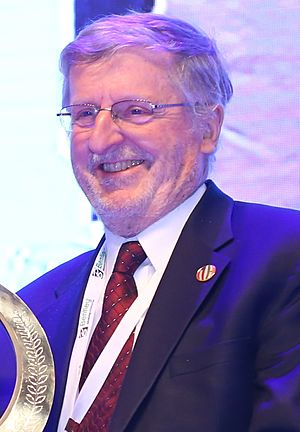Michael Frank Goodchild facts for kids
Quick facts for kids
Mike Goodchild
|
|
|---|---|

Michael Frank Goodchild in 2017.
|
|
| Born | February 24, 1944 |
| Education | University of Cambridge (BA) McMaster University (PhD) |
| Scientific career | |
| Institutions | University of Western Ontario University of California, Santa Barbara University of Washington Arizona State University |
| Thesis | The Generation of Small Scale Relief Features of Eroded Limestone: A Study of Erosational Scallops (1969) |
| Doctoral advisor | Derek C. Ford |
| Doctoral students | Alan Glennon |
Michael Frank Goodchild was born on February 24, 1944. He is a famous British-American geographer. He used to be a professor of Geography at the University of California, Santa Barbara. He worked at the University of Western Ontario for 19 years. In 1988, he moved to Santa Barbara to help start the National Center for Geographic Information and Analysis. He led this center for more than 20 years. In 2008, he also started the UCSB Center for Spatial Studies.
Contents
Michael Goodchild's Education
Michael Goodchild studied at two important universities. He earned his first degree, a Bachelor of Arts (BA), in Physics from Downing College, Cambridge in England in 1965. Later, he got his Ph.D. in Geography from McMaster University in Canada in 1969.
His Amazing Work in Geography
Michael Goodchild is best known for his work in Geographic Information Science, often called GIS. GIS is like a super-smart computer system that helps us understand and use maps and location data. He is also famous for coming up with the idea of "Volunteered Geographic Information." This means maps and location details that everyday people share, like when you add a photo to a map app. He is considered a top expert on this topic.
Exploring Caves and Karst
When Michael Goodchild was a student, he helped rediscover Castleguard Cave. This cave is in Banff National Park in Canada and is 20 kilometers long. It is the longest cave in Canada! His student, Alan Glennon, also found new parts of the Martin Ridge Cave System in Kentucky. This cave system is 51.8 kilometers long. Michael Goodchild's professor, Derek C. Ford, was an expert in karst science. Karst is a special type of landscape made of limestone, where caves and sinkholes often form.
Awards and Honors
Michael Goodchild has received many important awards for his work. These honors show how much he has contributed to geography and science.
- He became a Fellow of the British Academy in 2010.
- He was made a Foreign Member of the Royal Society in 2010.
- In 2007, he won the Prix Vautrin Lud in France, which is a very high award in geography.
- He became a member of the American Academy of Arts and Sciences in 2006.
- He received honorary doctorates from several universities, including Ryerson University and McMaster University in 2004.
- In 2003, he was given the Founder's Medal by the Royal Geographical Society.
- He became a member of the National Academy of Sciences in 2002.
- He received a Lifetime Achievement Award from the Environmental Systems Research Institute (ESRI) in 2001.
Related Topics
- Alexander Stewart Fotheringham
- Arthur Getis
- Concepts and Techniques in Modern Geography
- George F. Jenks
- Michael DeMers
- Technical geography
- Quantitative geography
- Qualitative geography
- Waldo Tobler

